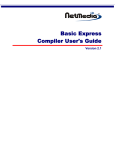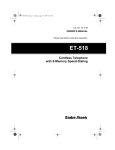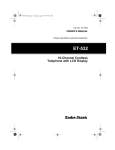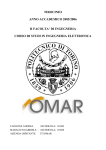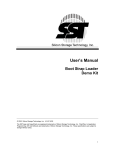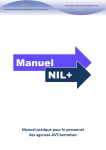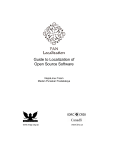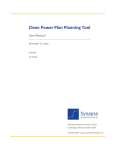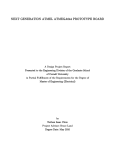Download Basic Express Com piler User's Guide
Transcript
Version 2.0 1998-2002 by NetMedia, Inc. All rights reserved. Basic Express, BasicX, BX-01, BX-24 and BX-35 are trademarks of NetMedia, Inc. 2.00H 2 Contents 1. Downloader...............................................................4 2. Editor and compiler.........................................................8 3. Project dialog box ........................................................11 4. BX-01 chip dialog box ......................................................13 5. BX-24 and BX-35 chip dialog boxes ...........................................16 6. Watch window ...........................................................18 7. Tutorial on using the watch window ...........................................20 8. File types ...............................................................23 9. Command line operation ....................................................26 3 Downloader The BasicX Downloader is where executable files are downloaded and run on the BasicX system. You can also use the Downloader to open the Editor/Compiler when creating or editing the BXP project or BAS source code files. The Downloader displays the results of the download process in the Status Bar. The Status Window allows interactive two-way RS-232 communication with the BasicX system. Downloader Window Open Download File Button The Open Download File Button loads a BXB and PRF file into the BasicX. The button will ask you for a BXB filename. Open Editor Button The Editor Button opens the BasicX Editor. This is where your project is opened, edited and compiled. Stop Processor Button On BX-01 systems, the Stop Processor Button turns off the power derived from the parallel port. The button is useful when changing components on the Developer Board. Warning -- this button has no effect on power supplied externally through the Power Port on the Developer Board. On BX-24 and BX-35 systems, the Stop Processor Button halts the processor but has no effect on power. 4 Execute Button The Execute Button tells the BasicX program to boot up and start running. This is indicated when the Status Bar says RUNNING. The Execute Button has the same effect as physically releasing the Reset Switch on the Developer Board. Reset Processor Button The Reset Processor Button halts BasicX program. This is indicated when the Status Bar says RESET. The button has the same effect as physically pressing the Reset Switch on the Developer Board, but the (software) button takes precedence over the physical switch. Download Program Button The Download Program Button loads a BXB file into the BasicX system. Clear Serial Window Button The Clear Serial Window Button clears the contents of the Status Window. Downloader Menus File Menu The File Menu allows you to open BXB and PRF files, or exit the BasicX Development Environment. The BXB files are BasicX binary executables created by the compiler, and PRF files contain additional information needed by the BXB file. Open Download opens user-specified BXB and PRF files. After you open the files, you use the Download button to load the program into the development system. Set Starting Directory allows you to specify the directory where the program initially looks for project files to open. 5 Capture File Window The Capture to File menu choice allows you to record data received by the monitor port on the PC. The data is stored in a user-specified file, which has a length limited only by available disk space. Recording continues until you close the file or exit the program. Processor Menu The Processor menu allows you to select which BasicX system type to use. Choices are BX-01, BX-24 and BX-35. I/O Ports Menu The I/O Ports menu allows you to configure communication ports. Download Port configures the port used for downloading programs to the BasicX. The download port may be either a parallel or serial port, depending on the BasicX system being used. If a serial port is used for downloading, you select only the com port number. Other settings, such as baud rate and parity, are fixed and cannot be changed by the user. Monitor Port configures the serial port that is connected to the status window. Here you can specify the PC’s com port number, baud rate, parity, number of data bits and number of stop bits.Note that the monitor port is bidirectional -- data received from a BasicX is displayed in the status window, and data you type into the status window is transmitted to the BasicX. Note that for systems that use serial downloading, the monitor port can be the same as the download port. The program switches between the 2 modes automatically. The Rescue function (BX-24 and BX-35 only) forces the processor to accept a new program (see page 7 for more detail). Progress Bar The Progress Bar displays the percentage of completion when downloading your program into the BasicX system. 6 Status Window The Status Window displays serial data received from the BasicX system as received by the monitor port on the PC. This window also accepts input from the PC keyboard for serial transmission to the BasicX. Warning -- the status window is intended for relatively simple communications with BasicX. The window does not incorporate any handshaking protocol when it communicates with a BasicX serial port. In practice, this is not usually a problem unless the BasicX is sending data at a high rate and the PC is loaded down with other processing tasks. In some cases the status window is able to detect communication errors, such as overflow of its input buffer. If an error is detected, the message "Serial Data Error Detected" is displayed to the right of the Progress Bar. Status Bar The Status Bar indicates the status of various elements of the system. These include power (on/off), processor state (running/reset) and program size. Title Bar The Title Bar indicates the BasicX Development System version number. Rescue function (BX-24 and BX-35 only) The Rescue function is an option that allows you to override a running processor and force it to accept a new program. The Rescue function is necessary because a BX-24 or BX-35 program can go into modes that prevent the system from accepting a new program, even if you manually reset the system or cycle the power. The BasicX Operating System needs to see the serial port in order to accept a new program. Anything that interferes with this, such as turning off interrupts for a significant amount of time, can cause problems. System calls PulseOut and PulseIn, for example, turn off interrupts temporarily while they' re executing. A program that spends a lot of time calling these or similar functions may need the Rescue function. Rescue allows the chip to communicate within 0.25 seconds of a pushbutton reset. Rescue halts the processor in a special way so it will communicate with the downloader no matter what kind of program you put in the chip. Recovery procedure: 1. Click on the Rescue function 2. Within the next 10 seconds, press and release the reset button on the processor. 3. After the 10 second period is up, the system should be ready for a new download. 7 Editor and Compiler The BasicX Editor/Compiler is where your project and its accompanying files are opened, edited and compiled. Title Bar and Tabs Editor Window The Title Bar displays the project currently open. The tabs and nested windows display the names of each module being edited. File Menu The File Menu opens and saves project and module files. Each BXP project file keeps track of the collection of modules that make up each program. Edit Menu The Edit Menu allows various editing operations, such as cut, copy, paste, search and replace. Rightclicking the mouse also displays a popup menu with several editing options. 8 Compile Menu The Compile Menu has options for compiling and running the project. Compile creates a BXB executable file. Compile and Run creates the file, downloads it to the BasicX and starts the program running. Compile Status displays the status of the last compile, including compiler error messages, if any. Options Menu In the Options menu, the Processor choice allows you to select which BasicX system type to use. Choices are BX-01, BX-24 and BX-35 (this menu item is a duplicate of one in the downloader window). The Environment choice opens a window (below) that allows you to control various environment settings. Various editor settings are available in the Editor Options tab, including tab width, font size and font type. Syntax highlighting is controlled by user-selectable colors for code, comments and string literals. Environment Window In the Project Options tab, you can specify that changes are automatically written to disk whenever you compile a program. Or you can have the compiler ask whether you want to save changes. You can also specify the following 3 compiler settings: Code optimizer This checkbox allows you to control whether the compiler optimizes the program. Optimization generally reduces the size of a program. Strict syntax rules This checkbox enforces various coding restrictions intended to make code easier to read and understand. The restrictions affect for-next loop counters, numeric literals and bitwise logical operations. See the language reference manual for more details. 9 Maximum string length This textbox allows you to specify the maximum allowable length of both variable-length and fixed-length strings. The selectable range is 1 to 64 characters, with a default of 16 characters. Since all variable-length strings require the same amount of storage, you can reduce overall storage requirements by selecting an optimum value for the string size. Project Menu The Project Menu has choices that affect the project. Chip opens the Chip Dialog Box with options to make common setup routines easier, such as defining the initial states of I/O pins. The Files choice opens the Project Dialog Box, which allows you to add or delete modules in the project. Watch Window allows you to watch variables in a running BX-24 or BX-35 program. Window Menu The Window menu allows you to specify how nested windows are displayed in the editor. Choices are Cascade, Tile Horizontal and Tile Vertical. Edit Window The Edit Window is where the code for the module files are created and edited. At the bottom of the edit window is the Status Bar: Status Bar The Status Bar indicates the status of various elements of the system. Panel 1 indicates the line and column number of the text cursor. Panel 2 shows whether the text cursor is in insert (INS) or overlay (OVR) mode. Panel 3 indicates whether errors or warnings were generated by the compiler. Panel 4 shows whether or not the compile was successful. If the compile was successful, panel 4 displays the amount of EEPROM memory used by code, the RAM allocated to static variables, and the nonvolatile memory allocated to persistent variables (abbreviated PRS). If the compile was not successful, a fatal error message appears in this panel. The above information can also be viewed in a separate window by clicking on the Status Bar or choosing Compile Status under the Compile Menu. You can also see more details of memory allocation by looking at the MPP map file, which is created whenever you compile a program. Warning – the RAM memory in the Status Bar applies only to memory allocated to static variables. This is not the same as the total amount of RAM required by a program. In particular, task stacks need additional RAM, which is not displayed here. 10 Project Dialog Box The Project Dialog Box keeps track of source code that makes up the project. Source code is stored in one or more module files, each of which has a default BAS extension. The collection of modules is compiled into the final BXB executable file. Project Dialog Window Title Bar The Title Bar displays the BXP filename of the currently-open project. Project Files The Project Files textbox lists all files in the project. Each file contains source code for a single module. You can select which files to include by pressing the Add/Remove Files buttons. Add File The Add File button opens a dialog box where module files can be chosen to be added into the current project. Remove File The Remove File button removes the highlighted file from the project. OK The OK button exits after saving any changes made within the Project Dialog Box. 11 BX-01 Chip Dialog Box The Chip Dialog Box allows you to control BasicX chip options such as external RAM, COM1/COM2 serial ports, internal SPI, SPI size and extended I/O. You can set network options such as baud rate and node/group address. You can also control the initial state of each I/O pin (note that some of these options can also be controlled by the BasicX program itself). External RAM The External RAM option configures BasicX to utilize the additional RAM of the RamSandwich . External RAM requires pins 2, 16, 17, 21-28, and 32-39. Cache The Cache option can be enabled when External RAM is utilized. When checked, it loads your program into memory where it will run faster. 12 COM1 The COM1 option configures BasicX to utilize the built-in COM1 device. This disables the network. COM1 requires pins 10 and 11. COM2 The COM2 option configures BasicX to utilize the built-in COM2 device, which requires pins 1 and 12. Extended I/O and RAM This option configures BasicX to utilize an external device such as the Video-X . Extended I/O requires pins 3, 21-28, and 32-39. SPI code storage The SPI Code Storage defines the maximum allowable program space available in the chip. The compiler checks to make sure your program fits in this memory. Internal EEPROM The Internal EEPROM option determines whether your program is downloaded internally to the BasicX chip, or externally to another SPI chip. External SPI requires pins 6, 7, and 8. Checking this box selects internal SPI and frees those 3 pins. Network Enable The Network Enable option configures BasicX to utilize the built-in network feature. The network requires the COM1 device and pins 10, 11, and 14. Node Address The Node Address sets the network address node for the processor. Each chip on a particular network must have a unique address. Valid node addresses are in range 0 to 65 279. Group Address This option allows you to define the group address of the chip. Multiple nodes on a network are allowed to share a common group address, and groupcasting allows you to send a network packet simultaneously to all members of a particular group. Valid group addresses are in range 0 to 254. Baud Rate The Baud Rate sets the network communication rate. The maximum (and default) is 460 800 baud. 13 OK Button The OK Button exits after saving any changes made within the Chip Dialog Box. Cancel Button The Cancel Button exits and disregards any changes made within the Chip Dialog Box. I/O Pin Grid The I/O Pin Grid allows you to define the initial state of each available I/O pin whenever the processor is rebooted. Each pin can be set to one of four states -- tristate, pullup, output-high and output-low: IN Input -- Configures the corresponding pin as a tristate (high impedance) input. Typically 5 V is logic high (on 5 V systems) and 0 V is logic low. P Input w/Pullup -- Configures the pin as an input with pullup. This state is typically used to sense the state of passive devices such as switches. 0 Output Low -- Configures the corresponding pin as a logic low output, which is 0 V. 1 Output High -- Configures the pin as logic high output, which is typically 5 V. The I/O Pin Grid defines only the initial states of each pin. After startup, you can also have the program configure each pin independently using procedure PutPin or other system calls. Known Bugs If you enable the cache option, the program will occasionally fail to start after download or reset. A workaround is to disable this option. 14 BX-24 and BX-35 Chip Dialog Boxes The BX-24 and BX-35 Chip Dialog Boxes allow you to control the initial state of the I/O pins and on-board LEDs on a BX-24. These options can also be controlled by the BasicX program. I/O Pin Grid The I/O Pin Grid allows you to define the initial state of each available I/O pin whenever the processor is rebooted. Each pin can be set to one of four states -- tristate, pullup, output-high and output-low: IN Input -- Configures the corresponding pin as a tristate (high impedance) input. Typically 5 V is logic high (on 5 V systems) and 0 V is logic low. P Input w/Pullup -- Configures the pin as an input with pullup. This state is typically used to sense the state of passive devices such as switches. 0 Output Low -- Configures the corresponding pin as a logic low output, which is 0 V. 1 Output High -- Configures the pin as logic high output, which is typically 5 V. The I/O Pin Grid defines only the initial states of each pin. After startup, you can also have the program configure each pin independently using procedure PutPin or other system calls. 15 OK Button The OK Button exits after saving any changes made within the Chip Dialog Box. Cancel Button The Cancel Button exits and disregards any changes made within the Chip Dialog Box. LEDS Box (BX-24 only) The LEDS box allows you to define the initial state of each of the two LEDs on the BX-24. You can also have your program control the state of each LED through pin I/O functions -- the red LED is connected to pin 25 and the green LED is connected to pin 26. To turn on an LED, you need to set the pin to logic low. Raising the pin turns off the LED. 16 Watch Window (BX-24 and BX-35 only) The Watch Window allows you to watch variables in a running BasicX program. The Watch Window can handle static (module-level) variables in RAM memory. Variables can be numeric or Boolean types. If an array is chosen, the first element of the array is displayed: Watch Window The Watch Window is chosen from the Project menu in the editor. The upper window lists RAM-based module-level variables in the program. The checkboxes allow you to select which variables to watch. The lower window displays the current values of the selected variables. The Watch Window periodically polls the BasicX processor to update each variable. The combo box at the bottom of the window allows you to tailor the sample rate by selecting from sample periods ranging from 1 second to 5 seconds. The Watch Window reads the BXM file, which is generated whenever a program is compiled. See the next section for details about the contents of the BXM file. 17 Warning -- the Watch Window requires the BasicX processor’s Com1 serial port in order to communicate. The program should not use Com1 while the Watch Window is active, and the monitor port should be closed. Also, anything that inteferes with serial communications, such as turning off interrupts, will interfere with the Watch Window. The following variables and objects are not displayed in the watch window: Local variables Persistent variables String variables Register objects Block data objects 18 Tutorial on using the Watch Window Procedure To illustrate the Watch Window, we' ll use the following program as an example. The objective is to display the value of static variable i while the program is running: Dim i As Integer Sub Main() i = 1 Do i = i + 1 If (i > 5) Then i = 1 End If Call Delay(2.0) Loop End Sub To start the Watch window, the first step is to open the editor and make sure BX-24 or BX-35 is selected in the Options-Processor menu: Processor Type window 19 The next step is to compile and download your program as usual. Once the program starts running, select the Project-Watch Window menu: Project-Watch Window menu 20 The Watch Window should appear. In the top window, you can choose one or more module-level variables to watch, and the compiler will dynamically update the values of each variable on the bottom window. Note that the variable type is displayed next to each identifier in the top window: Watch Window In this case, the variable test.i is updated about once per second. The update rate can be chosen from the combo box at the lower edge of the window. 21 File Types The compiler/downloader reads and generates the following files: File Extension Description BAS BXP PRF BXB MPP BXM MPX OBJ ERR Module file -- contains source code for the program. Project file -- lists all modules in program. Preferences file -- contains initialization and configuration information. BasicX program in binary format -- similar to EXE file on a PC. Map file of entire program, in human-readable format. Map file of static module-level variables, in machine-readable format. Map file of module level variables, in source code format for network. Object file -- contains object code for each subprogram Error log file, produced by command line mode BAS file This file contains the source code for a single module. Each module must be in a separate file, with one and only one module per file. File extensions can be arbitrary, with BAS as the default. The module name is taken from the filename without the extension. The module name must be a legal Basic identifier, which means the name must start with a letter, and all other characters must be letters, digits or underscores. BXP file This is the project file, which contains a list of the filenames of all modules in the program. Typical format: C:\Dir1\MainModule.bas C:\Dir3\SubDir\Irrigation.bas SerialPort.bas Filenames are prefixed by optional pathnames. If a pathname is absent, the compiler assumes the file is located in the same subdirectory as the BXP file. PRF file This is the preferences file, which contains information required by the BasicX system. Information includes the initial states of I/O pins, as well as memory configuration data. The combination of PRF and BXB file is required whenever you download a program to a BasicX system. BXB file The BXB file contains the executable code that is run by the BasicX chip. This file, combined with the PRF file, is similar to the EXE file on a PC. 22 MPP file This file contains a map of the entire program. The following categories are listed: Module-level RAM variables Persistent (EEPROM) variables Subprogram local data Code memory (subprograms and block data) BXM file The BXM file contains a description of all module-level (static) variables and arrays in the program. The file is in machine-readable ASCII text format. Each line in the file contains the following data in comma delimited format: ModuleName.VariableName -- Module name and variable (or array) name in quotes, using dot separator. MemoryLocation -- Address of the start of the variable. DataType -- Data type enumeration (see below). IsPersistent -- Whether variable is persistent. Value is #TRUE# or #FALSE# Dimensions -- Number of dimensions. Scalar is zero. The lower and upper bound of each dimension is listed for all eight possible dimensions. For string variables, the first upper bound is the maximum number of characters that can be stored in the string. Data type enumerations: Type Value UnsignedInteger Byte Integer Long UnsignedLong Single Boolean String 17 18 19 20 21 32 50 61 Example -- assume the file SerialPort.bas contains the following module-level declarations: Private Const InputBufferSize As Integer = 32 Private InputBuffer(1 To InputBufferSize) As Byte The BXM file contains this line: "serialport.inputbuffer",400,18,#FALSE#,1,1,32,0,0,0,0,0,0,0,0,0,0,0,0,0,0 23 Decoded values: ModuleName: VariableName: MemoryLocation: DataType: IsPersistent: Dimensions: LowerBound(1): UpperBound(1): LowerBound(2..8): UpperBound(2..8): "serialport" "inputbuffer" 400 Byte (18) False 1 1 32 0 0 MPX file This file contains information about module-level variables in source code format. The primary function of the MPX file is to provide information to a remote node on the network in order for the remote node to get read/write access to static variables on the local node. In the above serial port example, the MPX file contains the following lines pertaining to array InputBuffer: ' serialport_inputbuffer data type: Byte Public Const serialport_inputbuffer As Integer = 400 ' &H190 Public Const serialport_inputbuffer_IsPersistent As Boolean = False You can include the MPX file directly as a module in the remote program. Whenever you change the local program, the MPX file is updated automatically when you compile the program, which means you can recompile the remote program to update it. Note -- the address of each variable has a numerical range of 0 to 65 535. However, the MPX file uses 16-bit signed integer types in which to store these numbers, and addresses between 32 768 and 65 535 are actually represented as negative numbers in two' s complement format. The internal bit patterns correspond to the actual addresses. As an example, the apparent address -1 corresponds to real address 65 535 (&HFFFF). OBJ file These files contain the compiled object code for each subprogram. The files are written to the <Install>\Temp subdirectory, where <Install> is where the BasicX.exe program is installed. Whenever a BasicX program is finished being compiled, the OBJ files are no longer needed. You can erase all the files in the Temp subdirectory whenever the compiler is done. Warning – you should not run 2 or more copies of the compiler at the same time. This will cause the compilers to interfere with each other, since all object files are written to a common directory. 24 Command Line Operation The compiler and downloader may be invoked from a command line. This is useful when you' re using a third-party editor for writing your BasicX code. The syntax is as follows: BasicX Project /c /d BasicX - invokes the BasicX.exe file. If nothing follows this parameter, the BasicX Environment will start without a project. The pathname may also be required if the current directory is other than the installation directory. Project (optional) -- the name of your .BXP project file without the .BXP extension. You must set the starting directory to the location of this file. If nothing follows this parameter, the BasicX Environment will start with the specified project loaded into the editor. /c (optional) -- switch for compiling the project. This will create the .BXB file for your project. The BasicX Environment itself will not start when this switch is used. /d (optional) -- switch for downloading the project. This switch will download the .BXB file to your chip. The .BXB file must exist already if this switch is used without /c. The BasicX Environment itself will not start when this switch is used. The command line is not case sensitive. Each argument must be separated by 1 or more spaces or tabs. The project must be completely created as usual within the BasicX Environment. Once the source filenames and chip preferences have been established and saved in the project, you may then edit your source files in another ASCII editor and use the command line to compile and download the project. The starting directory, processor type (BX-01, BX-24, BX-35, etc.) and download port must be properly set for the current project. A message file named BasicX.err is created in the starting directory when you use the command line option. The file contains the processing results. If errors are encountered, the error number and description will be given along with any compile time errors, generally including the line number and filename of the source file causing the error. Example -- in the following example, file DemoProgram.bxp is located in the starting directory: C:\Program Files\BasicX\>BasicX DemoProgram /c /d This line causes the program to be compiled and downloaded. Note that BasicX.exe is assumed to be located in subdirectory \Program Files\BasicX in this example. This location can vary, depending on where the program is installed. 25


























